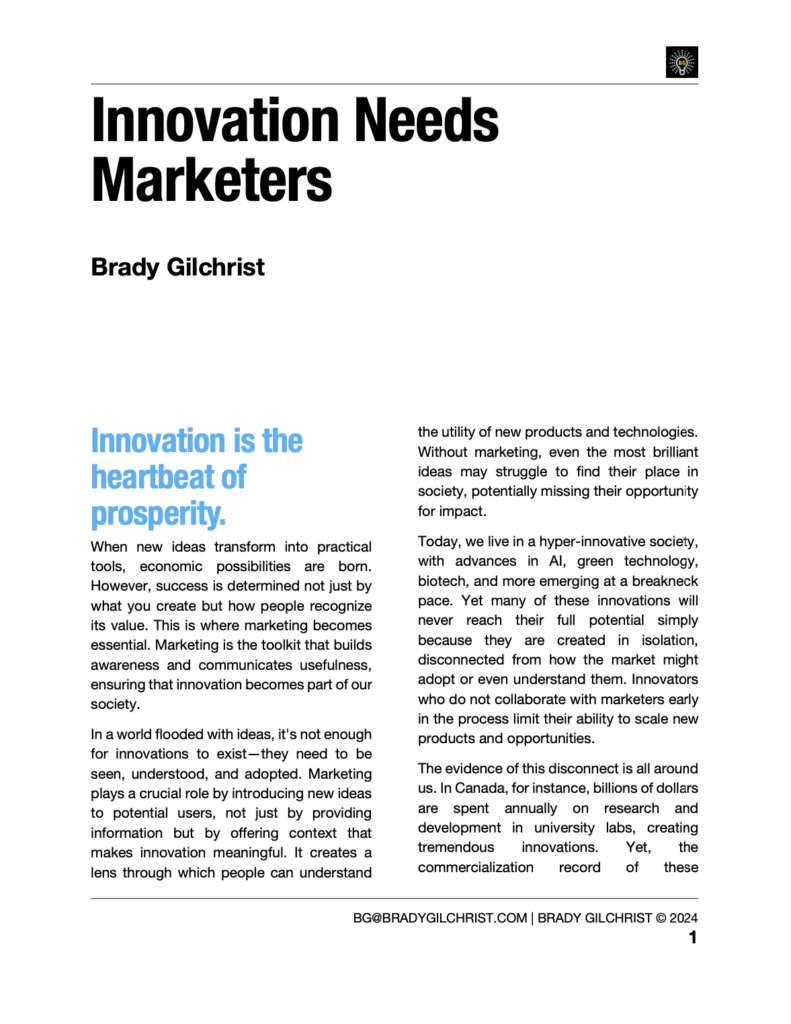Innovation is the heartbeat of prosperity.
When new ideas transform into practical tools, economic possibilities are born. However, success is determined not just by what you create but how people recognize its value. This is where marketing becomes essential. Marketing is the toolkit that builds awareness and communicates usefulness, ensuring that innovation becomes part of our society.
In a world flooded with ideas, it’s not enough for innovations to exist—they need to be seen, understood, and adopted. Marketing plays a crucial role by introducing new ideas to potential users, not just by providing information but by offering context that makes innovation meaningful. It creates a lens through which people can understand the utility of new products and technologies. Without marketing, even the most brilliant ideas may struggle to find their place in society, potentially missing their opportunity for impact.
Today, we live in a hyper-innovative society, with advances in AI, green technology, biotech, and more emerging at a breakneck pace. Yet many of these innovations will never reach their full potential simply because they are created in isolation, disconnected from how the market might adopt or even understand them. Innovators who do not collaborate with marketers early in the process limit their ability to scale new products and opportunities.
The evidence of this disconnect is all around us. In Canada, for instance, billions of dollars are spent annually on research and development in university labs, creating tremendous innovations. Yet, the commercialization record of these innovations remains subpar (as noted in the Auditor General’s Report on Innovation in Ontario). Integrating marketing with innovation from the earliest stages of development will propel breakthroughs into the market with greater speed and relevance.
For startups, the disconnect between engineering, science, and market understanding is often a key barrier to success. If markets are essential to the success of new ideas, marketing must be a central part of the startup equation. In today’s startup ecosystem, marketing is just as crucial as invention and creation. Marketers shape the narrative, humanizing complex technologies and making benefits understandable to consumers. Without this context, even groundbreaking science can fail to resonate with those it aims to serve.
Many organizations and innovators still struggle to understand how their creations will interface with the marketplace. Investing in that knowledge and building bridges between technical innovation and consumer need is more critical than ever. Scientists do science; inventors invent; marketers create markets, and markets drive the economy. When innovation and marketing are not linked, the likelihood of failure increases exponentially.
In today’s competitive, fast-moving world, coupling innovation with marketing is essential to ensure success. The modern marketer has become an interpreter of innovation, translating complex solutions into clear benefits that resonate with consumers and businesses alike. Organizations should prioritize making sure their innovations are expressed with clarity and meaning to make a lasting impact. Connecting technical innovation with human relevance is key to unlocking economic and societal advancement.
Canada’s Commercialization Crisis
Canada has long been recognized for its innovation potential, with substantial investments in research and development (R&D) across sectors like cleantech, biotechnology, and information technology. But despite this promising foundation, Canada faces a productivity crisis. The core of this issue isn’t the lack of ideas but a systemic failure to turn cutting-edge research into commercially viable products. The culprit? Canada’s ongoing struggle to bridge the “valley of death”—the gap between R&D and market commercialization.
Government agencies like the Business Development Bank of Canada (BDC), Sustainable Development Technology Canada (SDTC), and the National Research Council of Canada’s Industrial Research Assistance Program (NRC IRAP) along with various superclusters and incubators have all been set up to foster innovation. However, they often fall short when it comes to scaling and marketing these innovations. The space between early-stage research and successful product commercialization is still too wide—and it’s contributing to Canada’s stagnating productivity levels.
Efficiency The Current System: Well-Intentioned but Incomplete
The Canadian government has done well in funding early-stage research. Programs provide robust support for businesses engaged in applied research. But here’s the problem: the critical phases that turn a promising prototype into a market-ready product—commercialization, marketing, and scaling—are underfunded and lack the necessary expertise. Many small and medium-sized enterprises (SMEs), which represent a large portion of the Canadian economy, have the capacity to innovate but don’t have the resources or know-how to effectively market their innovations globally.
Compare this with countries like the United States and Israel, where innovation, commercialization, and marketing are tightly integrated. Their ecosystems ensure that R&D efforts reach the market and create real economic value. In contrast, many Canadian companies remain stuck in the prototype phase, unable to scale due to limited funding, lack of access to global markets, and insufficient marketing infrastructure.
The Role of the “Valley of Death”Redefined
The “valley of death” is where most Canadian innovations falter. This is the gap between research and commercialization, where innovations are left underfunded and unsupported in areas like market entry, intellectual property (IP) management, and marketing strategy. Without the backing to bring these innovations to market, Canada’s R&D investments often fail to generate meaningful economic returns.
For SMEs, which account for 85% of partnerships with Canadian polytechnics, the commercialization struggle is particularly pronounced. The challenges are even greater in sectors like cleantech, where long commercialization timelines and high capital demands make scaling more difficult.
Misallocation of Resources
Canada invests heavily in R&D, but the focus is disproportionately on the early stages. Most of the public funding goes toward prototype development, while commercialization receives far less attention. Without balanced funding across the entire innovation lifecycle, many ideas are stranded before they can make any significant economic impact.
Government efforts to foster academic-industry partnerships are commendable, but these efforts miss a critical point: marketing expertise is essential for SMEs trying to navigate complex global markets. In industries like cleantech, which require deep knowledge of regulatory environments and export markets, the absence of marketing infrastructure further stifles Canada’s productivity potential.
The Way Forward: Focus on Commercialization and Marketing
To address this systemic issue, Canada must shift its focus toward enhancing commercialization pathways and building marketing expertise. Here’s how we can make a difference:
- Expand Commercialization Funding
Existing R&D funding programs need to expand to include grants that specifically target commercialization and scaling. This will help businesses secure the capital needed to bring innovations to market, especially in high-cost industries like cleantech and biotechnology. - Develop Effective Commercialization Hubs
Creating commercialization hubs that focus on resources for market testing, IP management, and scaling can help bridge the valley of death. Modeled on successful programs from the U.S. and Europe, these hubs should provide a combination of funding and networking. So far the model in Canada has been not been effective. - Increase Marketing and Sales Expertise
Institutions must invest in marketing and sales training programs targeted at innovative industries. Building partnerships with marketing experts will give Canadian businesses the tools to compete globally and penetrate new markets. - Leverage Global Partnerships
Strengthening public-private partnerships and expanding Canada’s access to global markets through trade agreements and collaborations will provide the market access and insights necessary to scale globally. Government programs that incentivize international market entry will help SMEs grow. - Create Incentives for Venture Capital and Capital Expansion
Canada needs a more vibrant venture capital ecosystem to provide funding for late-stage commercialization. Tax incentives and public-private investment funds aimed at commercializing Canadian innovations globally will help foster this growth. Encouraging Canadians to invest in rational Canadian opportunities could be an excellent start.
Canada’s productivity crisis is not a failure of innovation—it’s a failure of commercialization. Without focused efforts to bridge the valley of death and build marketing expertise, we’ll continue to fall short in translating R&D investments into economic growth. A comprehensive strategy that prioritizes commercialization funding, builds marketing expertise, and leverages global partnerships is essential to unlocking Canada’s full innovation potential.

…

